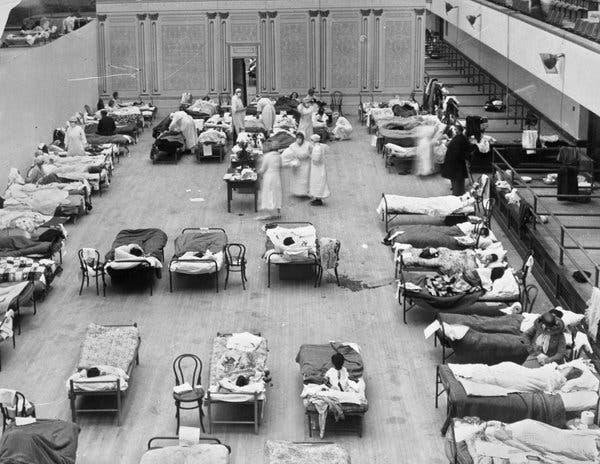Spanish flu was global killer
jmp.press@gmail.com
The Coronavirus has finally arrived here in the US. It’s now a matter of waiting to see how bad it could get. Will it go on to march unrestrained across the country?
But here’s the thing: …
This item is available in full to subscribers.
Subscribe to continue reading. Already a subscriber? Sign in
Get 50% of all subscriptions for a limited time. Subscribe today.
Please log in to continueNeed an account?
|
Spanish flu was global killer
jmp.press@gmail.com
The Coronavirus has finally arrived here in the US. It’s now a matter of waiting to see how bad it could get. Will it go on to march unrestrained across the country?
But here’s the thing: it’s happened before. And it happened right where we live.
I first learned about it when I was 13. We were visiting my Great-Aunt Martha on her little farm outside Trenton, Mo. She was a sweet, white-haired, apple-cheeked woman who had seen more than her Biblical three score and ten years. A relative was ill at the time and the old folks were discussing it. That led to talk of “the flu.” They all knew what that meant, for they had lived through it. They weren’t talking about your garden variety influenza that knocks people down every cold and flu season.
They meant “The Flu,” the deadly 1918–1919 Spanish Flu Pandemic.
“What was it like?” I asked. “Well,” Aunt Martha said after a thoughtful pause, “you wouldn’t want to get it.” That, I later learned, was a massive understatement. But Aunt Martha always put things as kindly as possible.
The illness mysteriously popped up out of the blue in Haskell, Kan., in early March, 1918. The local newspaper reported “18 cases of influenza of a severe type.” The strain was particularly savage. A person would wake up fine in the morning, start feeling unwell at noontime, and be dead by evening. It caused a fever so intense that patients begged to die. Lungs filled rapidly and victims then suffocated.
In a particularly troubling twist, the Spanish Flu focused on those in the prime of life. Most influenza strains target the vulnerable: the very young and the very old. Not so in this case. People from the late teens to the early 30s were most susceptible, though science cannot explain why.
The outbreak’s timing couldn’t have been worse, for it coincided with the First World War. Thousands of soldiers gathered in training camps where they coughed and sneezed on each other, then got on transport ships and sailed to France, carrying the virus with them. This was a world war, after all, so the illness moved with the military. In astonishingly short time, people were sick everywhere from the Polynesian Islands to the Antarctic.
The United States wasn’t spared. The flu spread from city to city, causing wholesale social upheaval as it went. Schools, churches, businesses, and movie theaters were closed for weeks. Train service was drastically reduced, making stores run low on food and essential goods as a result. When postal workers got sick, mail delivery ground to a halt. Funerals were held outdoors in hope the fresh air would protect mourners from the virus. It didn’t.
More than 200,000 people lined Philadelphia’s streets for a massive Liberty Loan Parade one morning in September 1918; hundreds of them were dying by nightfall.
Some state legislatures even passed laws that made spitting a crime to halt the spread. Again, it didn’t.
And everywhere you looked, there were masks. Young, old, middle-aged, everyone wore a white gauze mask over their nose and mouth. A few cities enacted laws mandating their usage, though some people openly resisted wearing them. Virology was in its infancy then, so folks didn’t realize gauze masks were useless.
Numbers tell the ultimate story. There were 105,000,000 Americans at the time; 675,000 of them died from the flu, more than were killed in World War I. In all, the illness killed some 20 million people worldwide. No wonder Aunt Martha shuddered when she described the experience 65 years later.
America’s collective memory is shamefully short, and most of our contemporaries know nothing about this horrible pandemic. History is a tough teacher, and its lessons are painfully to the point.
In this case, it happened here once and it could happen again. The next time you watch a thriller movie about a pandemic, remember it’s not that far-fetched. In this case, science fiction could become science fact. The human cost is too real, too painfully high. It was that way in 1918. It will be that way the next time, too.
Have comments, questions or suggestions you’d like to share with Mark? Message him at jmp.press@gmail.com.
Keywords
holy cow history, history, spanish flu, fluOther items that may interest you







Comments
No comments on this item Please log in to comment by clicking here